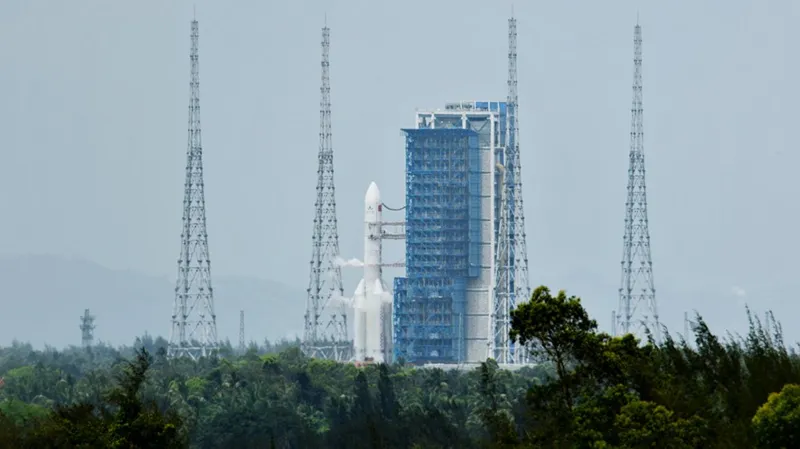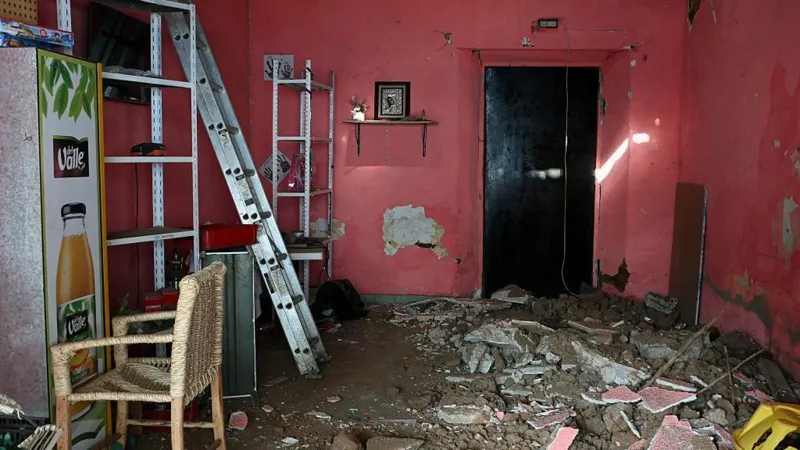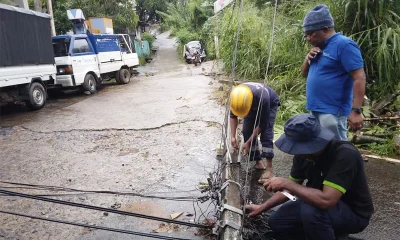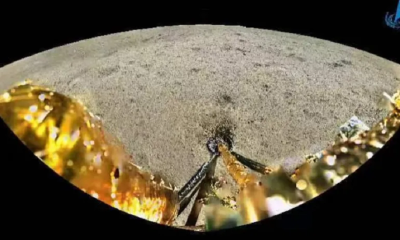Foreign News
China rocket blasts off for far side of Moon

China has launched a probe to collect samples from the far side of the Moon, in what is being billed a world first.
An unmanned rocket carrying the Chang’e-6 probe blasted off from the Wenchang Space Launch Center at about 17:27 local time (10:27 BST).
The 53-day mission aims to bring around two kilograms of lunar samples to Earth for analysis.
It will try to re-launch from the side of the moon facing away from Earth.
This is described as the dark side of the Moon because it is invisible from Earth, not because it does not catch the sun’s rays. It has a thicker, older crust with more craters, which are less covered by ancient lava flows than the near side.
This may make it more possible to collect material that helps shed light on how the Moon was formed, scientists hope.
Ge Ping, vice director of China’s Lunar Exploration and Space Engineering Center, told reporters ahead of the launch: “Chang’e-6 will collect samples from the far side of the Moon for the first time.”
The probe was named after the Moon goddess and one of the most popular figures in Chinese mythology.
It is expected to land in the South Pole-Aitken Basin, which is some 2,500km (1,553 miles) wide and up to 8km (5 miles) deep.
It then aims to collect lunar soil and rocks, and conduct experiments.
The launch marks the first of three high-wire unmanned missions to the moon planned by China this decade.
Chang’e-7 will search the lunar south pole for water, and Chang’e-8 will attempt to establish the technical feasibility of building a planned base, known as the International Lunar Research Station.
Its predecessor, Chang’e-5, retrieved the youngest ever lavas from the Moon on its return in December 2020.
Friday’s lift off marks the latest stage in China’s space exploration programme that is competing with the US.
Five years ago China became the first country to land a rover on the Moon’s far side.
By 2030, it aims to have put its first astronauts on the Moon, and to have sent probes to collect samples from Mars and Jupiter.
(BBC)
Foreign News
Two people killed in magnitude 6.5 earthquake in Mexico

At least two people have died after a powerful earthquake hit southern and central Mexico on Friday.
The epicentre of the 6.5 magnitude earthquake was near the popular tourist town of Acapulco, near San Marcos in the south-western state of Guerrero, which suffered moderate damage.
A 50-year-old woman died in Guerrero, the state’s governor Evelyn Salgado said, while Clara Brugada, Mexico City’s mayor, confirmed the death of a 60-year-old man and said 12 others had been injured in the capital.
Mexico is situated in one of the world’s most seismically active areas, sitting at the meeting point of four tectonic plates.
Late on Friday night, Brugada said power has been restored to “98% of the failures reported” in Mexico City.
Two structures were being evaluated for risk of collapse, she said, while 34 buildings and five homes were being inspected as a preventative measure.
Damage assessments are under way in Mexico City after roads and hospitals were impacted, according to news agency Reuters, while authorities noted various landslides on highways around the Guerrero state.
Mexico’s seismological service had registered 420 aftershocks by midday local time (18:00 GMT).
President Claudia Sheinbaum was holding her first press conference of the year when the earthquake struck.
In a video capturing the moment, Sheinbaum can be heard saying “it’s shaking” as an earthquake alert system rings in the background. She then tells the media to “all get out calmly”.
Additional footage shows buildings shaking in Mexico City and cars trembling in Acapulco.
After hearing the Mexican Seismic Alert System early on Friday, residents and tourists rushed into the streets of Mexico City and Acapulco.
The seismic system was put into place following the deadly 1985 earthquake that claimed more than 10,000 lives.
In 2017, a 7.1 magnitude quake, killed more than 200 people and toppled dozens of buildings in Mexico City.
(BBC)
Foreign News
US Coast Guard suspends search for survivors of Pacific boat strike

The United States Coast Guard has said it has suspended its search for survivors days after the US military said it struck two more boats in the eastern Pacific amid its ongoing military campaign in waters in and around Venezuela.
In a statement shared on its website on Friday, the Coast Guard said the three-day search had been focused on water “approximately 400 nautical miles [about 740km] southwest of the Mexico/Guatemala border” and had continued for more than 65 hours, but that no sightings of survivors had been reported.
(Aljazeera)
Foreign News
Over 400,000 Russians killed, wounded for 0.8 percent of Ukraine in 2025

Russia finished 2025 with what Ukraine described as an information operation designed to avoid engaging in peace talks and continue its war, despite suffering staggering casualties for meagre territorial gains this year.
On Monday, December 29, Russian Foreign Minister Sergey Lavrov accused Ukraine of attempting to assasinate Russia President Vladimir Putin at his residence at Lake Valdai, 140km (87 miles) northeast of Moscow.
“The Kyiv regime launched a terrorist attack using 91 long-range unmanned aerial vehicles (UAVs) on the state residence of the president of the Russian Federation in the Novgorod Region. All the UAVs were destroyed by the air defence systems of the Russian Armed Forces,” said Lavrov in a statement.
He did not say whether Putin was in residence at the time.
Lavrov’s Ukrainian counterpart, Andrii Sybiha, quickly dismissed the claim. “Almost a day passed and Russia still hasn’t provided any plausible evidence to its accusations of Ukraine’s alleged ‘attack on Putin’s residence’. And they won’t. Because there’s none. No such attack happened,” Sybiha said.
Russia produced photographs of drone debris lying in the snow two days later, but the drone’s location, manufacture and the time of its downing could not be corroborated from them.
“The attack on Putin’s Valdai residence is presumably a Kremlin fake,” wrote the opposition outlet Sota. “Residents of Valdai, where Putin’s ‘Dinner’ residence is located, told Sota that last night they did not hear the work of the air defence, which would have shot down 91 drones.”
Sota also pointed out that drones attacking Valdai “necessarily cross a specially protected airspace with objects of the Strategic Missile Forces, East Kazakhstan region, military aviation, closed administrative units such as Solnechny, Lake, etc.
“A drone crossing the territory of these facilities can fly to the Dinner residence only by miracle,” Sota said.
Lavrov’s claim also appeared at odds with an earlier announcement from the Russian Ministry of Defence that only 41 drones had been downed in the Novgorod region on the night of December 28-29.
Russia’s Defence Ministry later issued an update, saying another 49 drones had been shot down over Bryansk and one over Smolensk “flying in the direction of Novgorod region”.
Ukraine observers pointed out that Bryansk and Smolensk are hundreds of kilometres from Valdai.
The Institute for the Study of War (ISW), a Washington-based think tank, stated that none of the usual evidence of Ukrainian strikes accompanied the alleged attack, such as footage, heat signatures, statements from local officials, or local media reports.
For example, a successful Ukrainian attack against an oil depot in Rybinsk on December 31 was well-documented on social media. So was an attack on the Novoshakhtinsk refinery in Rostov a week earlier, as well as a number of other strikes during the week.

News of the alleged attack came a day after Ukrainian President Volodymyr Zelenskyy concluded successful talks with United States President Donald Trump in Florida, garnering a promise that US forces would participate in Ukraine’s security following any peace agreement with Russia.
It was the first time the US had agreed to such security guarantees, and it appeared to make Polish Premier Donald Tusk optimistic that the war in Ukraine could end early in 2026.
“Peace is on the horizon,” he told a cabinet meeting on Tuesday.
“The key result of recent days is the American declaration of willingness to participate in security guarantees for Ukraine after a peace agreement, including the presence of American troops, for example, on the border or on the line of contact between Ukraine and Russia,” Tusk said.
Zelenskyy said Ukraine’s allies, known as the Coalition of the Willing, were scheduled to meet in Kyiv on January 3 and in France three days later.
Lavrov’s announcement cast a pall on this optimism when he said, “Russia’s negotiating position will be reviewed.” On the same day, Putin ordered his forces in southern Ukraine to continue efforts to seize the unoccupied remainder of the southern Ukrainian region of Zaporizhia. Moscow controls three-quarters of the region.
Zelenskyy said Russia was “looking for a pretext” to escalate hostilities and avoid engaging in peace talks, following his successful meeting with Trump.
“Russia is at it again, using dangerous statements to undermine all achievements of our shared diplomatic efforts with President Trump’s team,” he wrote on social media.
Russia has repeatedly dashed Trump’s hopes for peace, refusing to cede occupied territory or to accept US and European forces on Ukrainian soil.
Yet Trump appeared to believe Moscow’s allegations.
“I don’t like it. It’s not good,” Trump told reporters on Monday. “It’s one thing to be offensive… It’s another thing to attack his house. It’s not the right time to do any of that. And I learned about it from President Putin today. I was very angry about it.”
Other US officials were not convinced. US Ambassador to NATO Matthew Whitaker expressed scepticism, telling an interviewer on Monday, “It’s unclear whether it actually happened.” On Wednesday, the Wall Street Journal reported that US intelligence had determined that Ukraine did not target Putin’s residence.
Moscow’s messaging appeared to bookend Zelenskyy’s meeting with Trump, targeting the US president.
Putin held staged meetings with his General Staff on Saturday, December 27, and Monday, just before and after Zelenskyy’s meeting with Trump, during which commander-in-chief Valery Gerasimov broadcast exaggerated claims of success.
He said Russian forces had occupied 6,640 square kilometres (2,564 square miles) of Ukrainian territory and seized 334 Ukrainian settlements in 2025. The ISW said it had “observed evidence indicating a Russian presence in 4,952 square kilometres (1912 sq miles)” and 245 settlements.
Ukrainian commander-in-chief Oleksandr Syrskii said territory amounting to 0.8 percent of Ukraine’s 603,550sq km (233,032sq miles) had been lost. at the cost of almost 420,000 dead and wounded Russians.
Ukraine’s General Staff estimated total Russian casualties for the war at more than 1.2 million, almost 11,500 tanks and 24,000 armoured fighting vehicles, more than 37,000 artillery systems, 781 aircraft and well in excess of 4,000 missiles.
By the end of 2025, Russian forces had still not taken Pokrovsk and Myrnohrad, the eastern Ukrainian towns in Donetsk that they had been fighting to capture for five months. They held 55 percent of Hulyaipole in the southern Zaporizhia region, despite claiming to have seized it. Even Russian military reporters admitted Russian forces were being squeezed out of Kupiansk in the northern Kharkiv region, despite claiming also to have seized that.
“Due to inaccurate reports on the situation to higher authorities, reserves that were ‘not needed’ for the capture and clearing of Kupiansk were redeployed to other areas,” wrote one Kremlin-friendly outlet, citing “systematic exaggeration of successes”.
While it remained doubtful whether Ukraine did target Valdai, Russia’s attacks on Ukrainian cities were documented. During the last week of the year, Russia launched just more than 1,000 drones and 33 missiles at Ukraine’s cities. Ukraine’s Air Force said it intercepted 86 percent of the drones and 30 of the missiles.


[Aljazeera]
-

 Sports6 days ago
Sports6 days agoGurusinha’s Boxing Day hundred celebrated in Melbourne
-

 News4 days ago
News4 days agoLeading the Nation’s Connectivity Recovery Amid Unprecedented Challenges
-

 Sports7 days ago
Sports7 days agoTime to close the Dickwella chapter
-

 Features5 days ago
Features5 days agoIt’s all over for Maxi Rozairo
-

 News7 days ago
News7 days agoEnvironmentalists warn Sri Lanka’s ecological safeguards are failing
-

 News5 days ago
News5 days agoDr. Bellana: “I was removed as NHSL Deputy Director for exposing Rs. 900 mn fraud”
-

 Opinion3 days ago
Opinion3 days agoRemembering Douglas Devananda on New Year’s Day 2026
-

 News4 days ago
News4 days agoDons on warpath over alleged undue interference in university governance

















